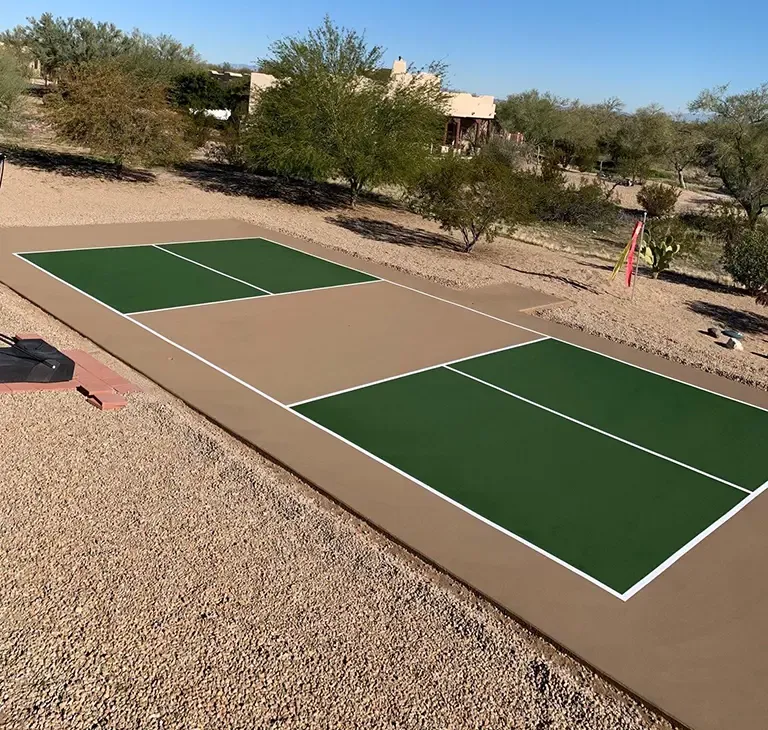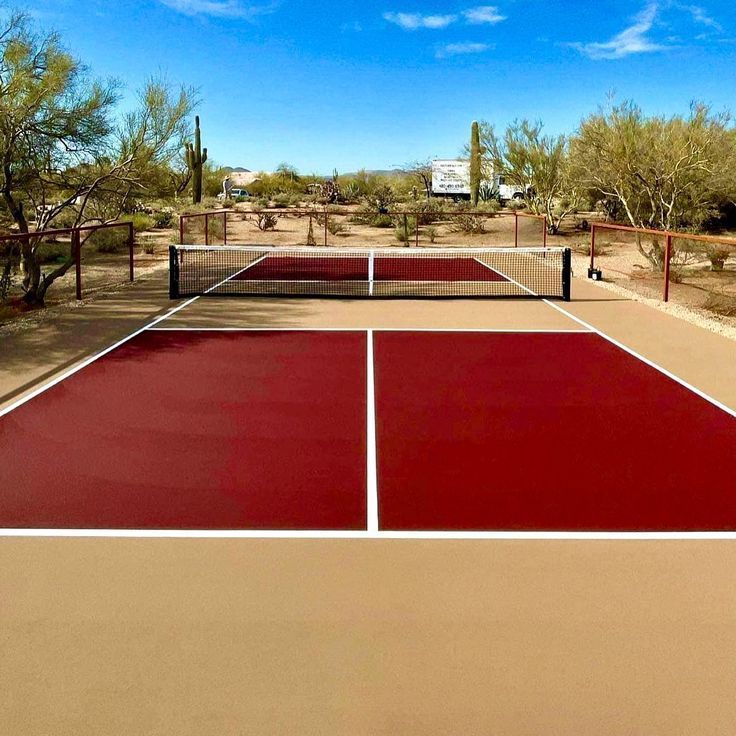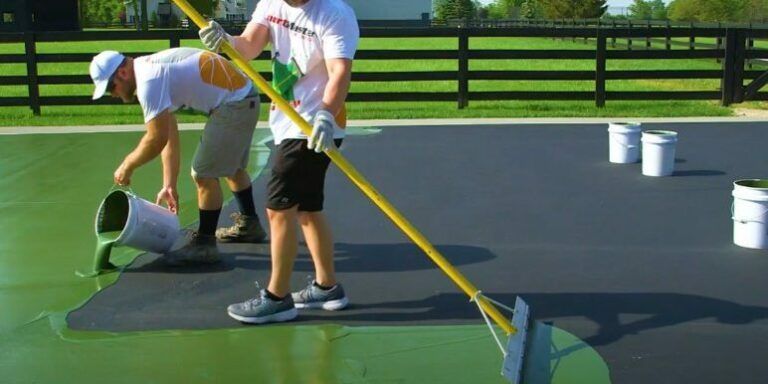Planning your dream backyard pickleball court
In embarking on the journey to build a backyard pickleball court, the initial step is to plan meticulously. This involves understanding your available space, setting a budget, and choosing the court's layout.
Finding the perfect spot
To ensure a seamless playing experience, determining the required space is crucial. The standard dimensions for a pickleball court are 20 feet wide by 44 feet long. However, to accommodate player movement and safety, it is advisable to aim for an area of at least 30 feet wide by 64 feet long. Think of this space as the canvas upon which you’ll paint your thrilling matches.

When scouting for the perfect spot, consider the sun's orientation. Yet, while you bask in the sun's warmth, protect yourself from its harsh glare by orienting your court north-south. Additionally, incorporating shade structures will enhance player comfort during those hot summer nights. It’s also essential to ensure proper drainage; a well-drained court will withstand the elements, saving you from potential headaches down the road.
Budgeting for your court
Setting a budget is one of the most fundamental aspects of planning. The costs associated with constructing a pickleball court can vary widely based on surface materials, labor, equipment, and additional features. For a more budget-friendly DIY approach, expect to invest between $5,000 to $10,000 for a functional setup. This might include simple elements like a portable net and some tape for marking lines. In contrast, professional installations can easily soar up to $40,000, factoring in premium materials and features like fencing and lighting.
To economize, consider phasing your project maybe start with a basic setup and upgrade later as your needs evolve. Your budget will dictate many decisions, ensuring that your dream court doesn't break the bank.

Choosing the right surface
Selecting the appropriate surface for your court is more than just a matter of aesthetics; it directly impacts gameplay and maintenance. Let’s explore the common options available, each with its unique characteristics.

Concrete courts
Concrete is a popular choice for pickleball courts, renowned for its durability and low maintenance requirements. Think of it as the sturdy foundation upon which many architectural marvels are built. Its smooth surface allows for consistent ball bounce, making it a preferred option for serious players. However, it’s essential to note the installation process; proper base preparation is paramount, which can add to the overall cost. While concrete may require an initial investment, its longevity and low maintenance costs mean you won’t be continually pouring money into repairs or resurfacing.
Asphalt courts
On the other hand, asphalt offers a more budget-friendly alternative. It's relatively easy to install and can be resurfaced over existing surfaces, making it an attractive option for remodels. Though asphalt requires more maintenance than concrete, it possesses its charm when it comes to installation flexibility. One of the key advantages of asphalt is its ability to hold up well against harsh weather conditions, ensuring a reliable playing surface year-round.
Modular tile systems
For those seeking versatility, modular tile systems present an innovative solution. These cushioned tiles can be laid over existing surfaces and are designed with players' comfort in mind. They provide excellent ball bounce and are much easier on the joints, significantly reducing the risk of injury. Various brands like SnapSports and VersaCourt offer a range of color options and designs, paving the way for creative court layouts that reflect your personality and style. However, the installation might require a bit more effort than traditional surfaces, as you’ll want to ensure each tile is laid out evenly for optimal play.
DIY or hire a pro?
As you progress through your planning, you’ll face a fundamental choice: should you undertake the project yourself or engage professional help? Each option carries its own pros and cons, often reflecting your skills, budget, and timelines.
Assessing your DIY skills
Before diving into a DIY endeavor, it’s crucial to evaluate your skills. Are you equipped with the necessary tools? Do you have past experience in construction or landscaping? Understanding the complexity of the project is vital some might liken it to building a sandcastle; without a solid foundation, your creation may crumble before your eyes. Begin by familiarizing yourself with the layout process, necessary surfacing, and marking techniques. If you feel confident and your schedule allows for it, a DIY approach can not only save you money but also provide a sense of accomplishment.
Finding the right contractor
If DIY feels too daunting, choosing a reputable contractor to build your court might be the way to go. Look for experienced professionals who specialize in pickleball court construction. Gathering customer reviews, checking qualifications, and asking for references can help ensure you’re making an informed decision. It’s similar to finding a trustworthy guide for a mountain hike; you want someone who knows the terrain and has achieved success in navigating it before. Moreover, consider forming a relationship with your contractor open communication can lead to better outcomes, with your preferences carefully integrated into their plans.
Essential pickleball equipment
Once you have the court in place, the next step is to acquire the essential pickleball equipment. This includes nets, paddles, balls, and various accessories that enhance your gameplay.
Choosing the right net
A regulation-size pickleball net is crucial for ensuring fair play. It typically measures 22 feet wide, with a height of 36 inches at the sides and 34 inches at the center. As you explore your options, you’ll find diverse choices, including portable nets perfect for family gatherings, or permanent setups that securely anchor into your ground. Installation can be straightforward, but understanding the specifics of net height and guidelines is vital to being game-ready from day one.
Selecting pickleball paddles
Choosing the right paddles is essential for optimal play. Pickleball paddles come in various materials, including wood, composite, and graphite, each affecting weight and control characteristics. For beginners, a lightweight paddle can enhance maneuverability. Meanwhile, intermediate and advanced players might prefer graphite paddles for better power and accuracy. Your choice should reflect your play style and the skill level you wish to attain.
Pickleball balls
Lastly, an often-overlooked detail is selecting the right pickleball balls. They come in two main types: indoor and outdoor balls. Indoor balls tend to be lighter and have larger holes, while their outdoor counterparts are sturdier and designed to withstand wind and other weather conditions. Proper selection can greatly influence the quality of your play.
Enhancing your court
After establishing the foundational elements of your court, it’s time to think about enhancements that will improve functionality and create a more enjoyable environment.
Fencing options
Installing fencing around your court offers several benefits, including ball containment and added privacy. Fencing materials vary from wood to chain-link options, each coming with unique advantages. A well-constructed fence can infuse your backyard with a professional appearance transforming your space into a polished area for thrilling matches. When considering installation costs and maintenance, think of it like framing a beautiful piece of art; it shouldn't only serve a function but also enhance the overall aesthetic appeal.
Illuminating your court
Proper lighting plays a vital role in maximizing your playing time. If you're inclined to play in the evenings, consider installing LED lights that are energy-efficient and provide bright illumination. Strategically placed poles can light up all corners of your court, ensuring that darkness never compromises your game. The thrill of a sunset pickleball match can quickly turn into a memorable experience with friends and family.
Creating a comfortable playing environment
Finally, comfort shouldn’t be overlooked. Adding features like seating and shade structures will create a welcoming atmosphere where players can relax between games. A well-placed bench or awning can transform your court from a simple playing field into a community hub. Think about landscaping, perhaps planting flowers or shrubs nearby; doing so can add beauty and offer a touch of nature to your backyard retreat.
Maintaining your pickleball oasis
Regular maintenance is key to ensuring the longevity and appeal of your backyard pickleball court.
Keeping your court clean
Keeping the court clean is vital for preserving the integrity of your playing surface. For concrete, asphalt, or modular tiles, regular sweeping helps remove debris think of it as tidying up your living space for best enjoyment. Plus, washing your court helps maintain a vibrant look and prevents the development of slippery algae or moss.
Repairing cracks and damage
Like any home feature, wear and tear is inevitable. Regular inspection for cracks or damage can prevent serious long-term issues. Use patching compounds and sealants to address minor damage and to keep your surface looking fresh. For more extensive issues, resurfacing might be necessary, especially once the court shows signs of deterioration.
Net and equipment care
Properly caring for your equipment prolongs its lifespan. Always properly store your pickleball net after use, ensuring that it’s dry and clean to prevent mold or decay. Routine inspections can allow for timely repairs, thereby enhancing the safety and quality of your games.
Making it multi-sport friendly
For those wanting to maximize their backyard use, consider designing the court to accommodate multiple sports, allowing for year-round fun.
Incorporating other sports
By marking lines for sports like basketball or tennis, your pickleball court can become a multifunctional playground. Doing this requires attention to detail including ensuring the dimensions and equipment compatibility are up to standard. It’s akin to hosting an array of events in a theater space; flexibility can increase engagement and enjoyment for everyone involved.
Choosing multi-sport surfaces
Opt for modular tile systems specifically designed for multi-sport use. Not only do these surfaces perform well across different sports, but they also facilitate superior bounce and player comfort. Your backyard can transform into a vibrant hub for various community sports or family games, increasing its value and usage potential.
Pickleball etiquette and safety
Finally, promoting good sportsmanship and safety on your court cannot be overstated.
Basic rules
Familiarize yourself and players with key etiquette and rules, emphasizing fair play and respect for fellow competitors. Establishing ground rules early ensures that everyone enjoys their time, fostering a friendly and competitive environment.
Preventing injuries
To maintain a safe experience, prevent injuries by encouraging warm-ups, stretching, and hydration. Wearing proper footwear can greatly reduce the likelihood of slips or strains during intense matches.
Being a good neighbor
Lastly, while your passion for pickleball is contagious, always remain considerate of your neighbors. Limit late-night play and communicate openly about scheduled games to foster positive relationships.
Building your backyard pickleball court can be a rewarding and exhilarating project that brings friends and family together. From careful planning to equipment selection and maintenance, each aspect contributes to creating a harmonious sanctuary for play and recreation. By following these guidelines and maintaining respect for the game along with your fellow players and neighbors you’ll ensure that your pickleball dream takes flight, transforming your backyard into a thriving hub of sportsmanship and joy.










